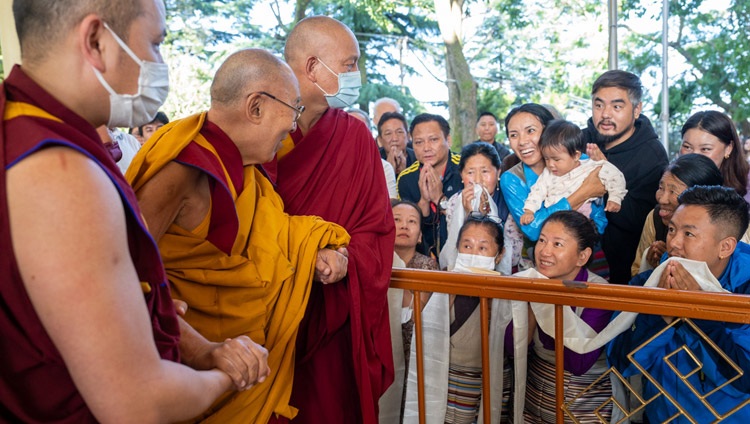
His Holiness the Dalai Lama greeting members of the crowd gathered in the courtyard of Main Tibetan Temple to attend the second day of teachings in Dharamsala, HP, India on September 6, 2023. Photo by Tenzin Choejor
September 6, 2023. Thekchen Chöling, Dharamsala, HP, India – This morning the weather was brighter as His Holiness the Dalai Lama walked from his residence to the Tsuglagkhang. The courtyard was filled with the sound of mantras, Om ara patsa na dhi and Mig-tse-ma. Once His Holiness reached the temple, Theravadin monks chanted the Mangala Sutta in Pali, following which Vietnamese monks chanted the ‘Heart Sutra’ in their own language. Representatives of the various Buddhist groups in attendance offered a mandala and representations of the body, speech and mind of the Buddha. The ‘Heart Sutra’ was chanted once more in Tibetan while tea and bread were distributed to the congregation.
To begin with His Holiness reported an occasion during a pan-Buddhist gathering in Varanasi when he had a clear vision of the Buddha. He felt the Buddha recognised how he had studied his teachings and cultivated the awakening mind of bodhichitta and the view of emptiness in practice,
“Although almost 2600 years have passed since the Buddha was alive, his teachings continue to flourish because there are people who study, practise and share them with others.
“What’s important in terms of preserving ethics and practising the teaching is for the teaching to flourish within us. I was born near the border of Tibet and I’ve pursued the Dharma since I was a child. I’ve studied works from the Three Collections and applied the threefold approach of study, reflection and meditation. Practising the teachings entails cultivating the mind within.
“Understanding reality involves coming to understand that phenomena do not exist as they appear to us—as solid and independent. Their existence is merely designated.
“These days there are many people in traditionally Buddhist countries who are renewing their interest in what the Buddha taught because it is akin to science. In due course they may look back and see that what they initially thought was unattainable, cultivating the altruistic awakening mind and a clear view of emptiness, can be achieved after all.
“Cultivating a good heart brings benefit to yourself and others. It leads to your showing others love and affection. Modern education tends to focus on material development to the neglect of inner values. But if you can cultivate a good heart, it will bring you peace of mind. If you’re warm-hearted you’ll find you naturally attract more friends.
“The crucial thing is to combine compassion for others with an understanding that persons and phenomena are empty of inherent existence. I’ve put these two principles into effect and they have brought me great benefit. Things appear to have some sort of essential existence, but it is only an appearance.”
His Holiness turned to the ‘Auto-commentary’ to Chandrakirti’s ‘Entering into the Middle Way’ and read through the fourth chapter. This focusses on diligence or joyous effort, which is the source of all good qualities. The Bodhisattva on the fourth ground is known as Radiant. His Holiness reported that his junior tutor, Trijang Rinpoché used to joke that because the senior tutor, Ling Rinpoché, had a shiny, bald head he was ‘radiant’.
His Holiness announced that he wished to lead the congregation through the process of the all-encompassing yoga mind. He explained that the best way to fulfil your own interest is to cultivate a good heart. He pointed out that even birds and animals appreciate kindness.
Being kind to others, he said, is a true source of happiness. He remarked that peace in the world will not come about because of official resolutions and declarations but because individuals develop a good heart. He clarified that experiencing our mother’s love and affection at the beginning of our lives is ultimately the basis on which we can build peace in the world. The essence of a good life is to have a good heart.
He asked his listeners to meditate briefly on what he had said and then to imagine that these thoughts transformed into a moon disk at the heart.
Next His Holiness asked the members of the audience to examine themselves, to ask where was their self. Where is the sense of ‘I’ that appears to control our body and mind.? He explained that there is a person who works to help others, for example, but there is no independent, solid self as there appears to be. Again, he invited his listeners to meditated briefly on what he had said and to imagine this insight transforming into a white, five-spoked vajra standing on the moon disk previously visualized at the heart.
He confirmed that these two principles, the awakening mind of bodhichitta and the view of emptiness, comprise the core of his own practice. He assured his listeners that if they meditate steadily on these ideas, they will be able to transform their minds.
In answering a question from the audience His Holiness stated that generating concentration alone is insufficient to counter wrong views. To do that it’s also necessary to cultivate analytical meditation.
As the session came to an end representatives of the attending Buddhist groups offered a thanksgiving mandala. There was then a recitation of a prayer for His Holiness’s long life composed by Jamyang Khyentse Chökyi Lodrö. Finally, members of the various Buddhist groups were able to have their photographs taken with His Holiness.
https://www.dalailama.com/news/2023/entering-into-the-middle-way-2023-second-day